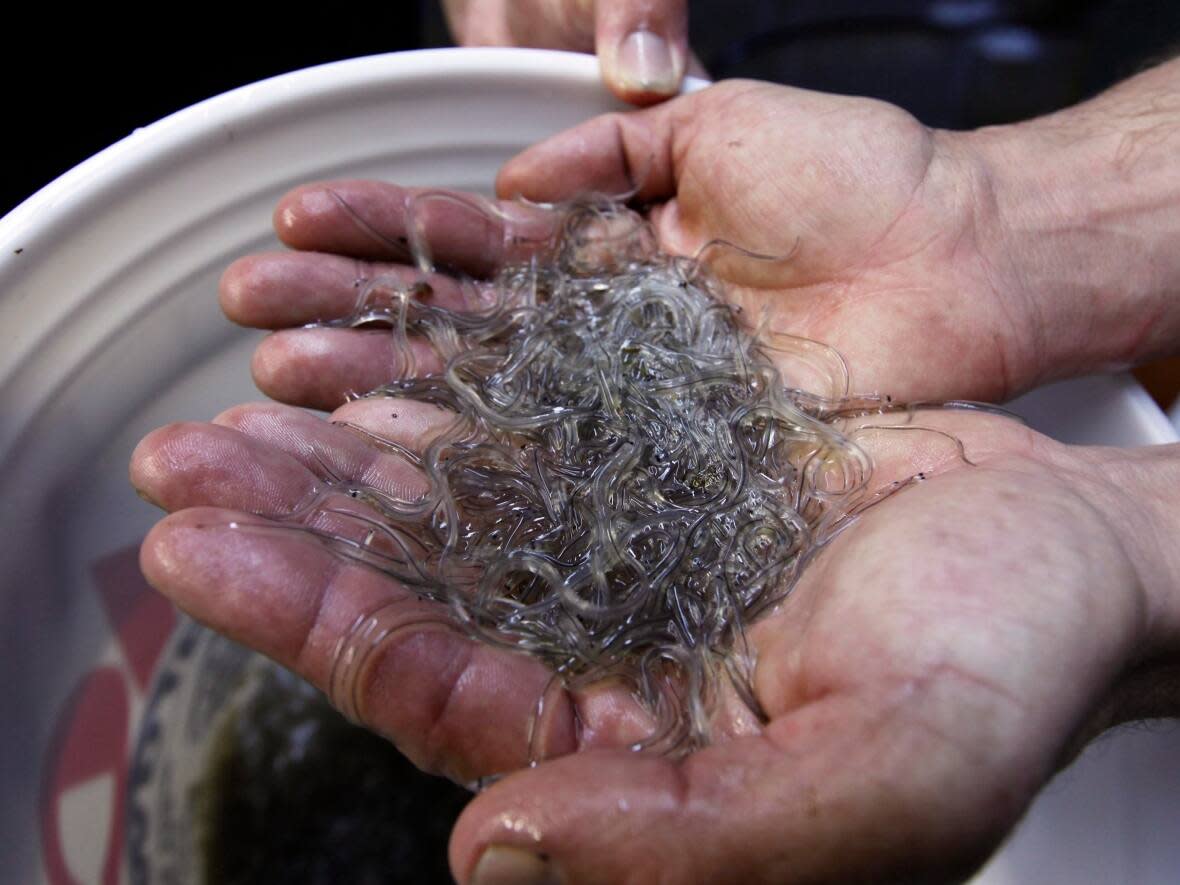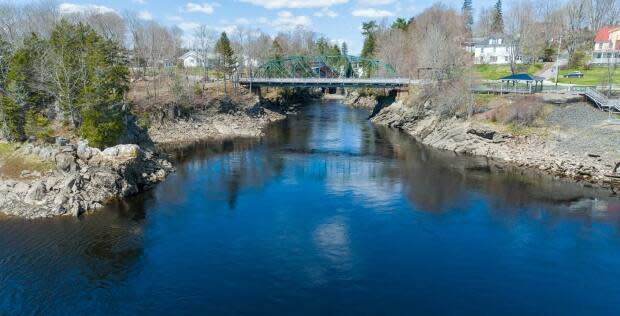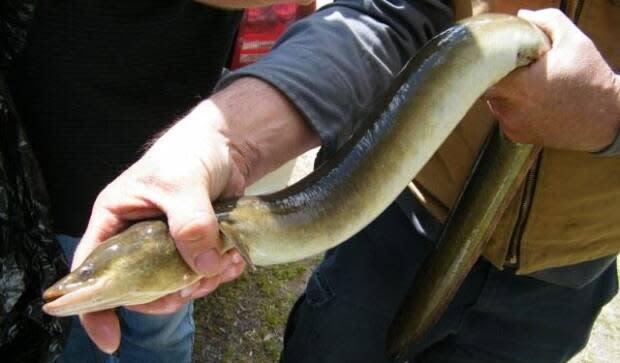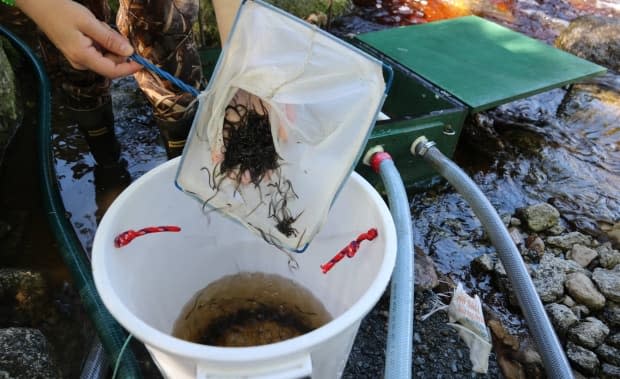Dispute over baby eels worth $4,900 a kilogram heads back to N.B court

Canada's most valuable fishery per kilogram will be back before the courts in Saint John next week in a case that pits a longtime commercial licence holder against Indigenous fishers who want a piece of the elver action.
On one side, the original plaintiff in the case accuses Indigenous groups of poaching the baby eels in waterways where she has exclusive rights to fish. On the other side, Indigenous groups want to exercise the right to engage in a moderate livelihood commercial fishery in their traditional territory.
In April, Mary Ann Holland applied to the Court of Queen's Bench for an injunction to stop several groups and individuals from fishing her waterways, and from threatening and intimidating the people who were catching for her company.
The lawsuit named Neqotkuk, also known as Tobique First Nation, Sitansisk Wolastoquiyik, or St. Mary's First Nation, Welamukotok, or Oromocto First Nation, and Woodstock First Nation, along with the four chiefs and some other individuals.
In documents filed with the court, Holland acknowledged that Maliseet, or Wolastoqey, are entitled to engage in a limited moderate livelihood commercial fishery in their traditional territory but have historically never fished for elvers "for food, social, or ceremonial purposes."
In a joint statement issued in May, the chiefs vowed to fight the claims.

They said the Wolastoqey and other Indigenous people have a right to earn a livelihood through fishing by virtue of Section 35 of the Canadian Constitution and the Peace and Friendship treaties of the 18 century.
In response to Holland's request for an injunction, the defendants filed their own motion with the court, asking for Holland's statement of claim to be struck. In court documents, they have also asked for a number of things, including, including an order "striking out" the plaintiff's statement of claim because, among other things, "it is scandalous, frivolous, and vexatious."
They also want more information from the plaintiffs on many of the allegations contained in the statement of claim.
A hearing on that motion has been scheduled in the Court of Queen's Bench in Saint John on Tuesday.

The defendants want to know the names of the people the plaintiffs allege "interrupted and hampered" the plaintiffs while they tried to fish for eels. They also demand to know exactly what activities are alleged and where they happened. They also want to know how the plaintiffs "came to know they were a member of that First Nation."
The motion also asks whether the chiefs named as defendants — Timothy Paul, Shelley Sabattis, Alan Pochies, and Ross Perley — were present during the alleged incidents.
In response to the demand for particulars, the plaintiffs repeatedly stated that the details were contained in the original statement of claim.
Roots of the case
The court case began in April, when Holland applied for the injunction to stop Indigenous groups from fishing areas where she claims "exclusive" rights to fish, and from threatening and intimidating her workers.
She said things came to a head on the Magaguadavic River, and others in southwestern New Brunswick in the St. Stephen-St. George area at the end of April. According to court documents, she said Indigenous fishermen "positioned themselves and their nets so as to reduce the number of elvers which could be caught by said fishers … and proceeded to poach the elvers for themselves."
On April 29, Justice Danys Delaquis granted an interim order, telling the defendants to stop "threatening, coercing, harassing or intimidating" the plaintiff and the plaintiff's fishers. The defendants were also ordered to stop fishing the plaintiff's designated watercourses.
But in another affidavit by Holland, she said the defendants were back on the water the same day the judge made the interim order.

On May 19, Justice Danys Delaquis granted an injunction against the defendants, ordering them to stop "threatening, coercing, harassing or intimidating the Plaintiffs and their fishers, and harvesting elders on the Plaintiffs' licence designated watercourses and ordering, directing persuading, aiding, abetting, and encouraging other persons to commit the above pending the disposition of the action or further order of the court."
In his decision, Delaquis said the defendants "are undoing what the plaintiffs have done for over three decades with respect to the elver fishery."
He also said the plaintiffs' reputation "will also be irreparably harmed unless the defendants' conduct is restrained."
"Lastly, the Defendants have put the court on notice that they have no intention of following any orders it renders. Such behaviour is not condoned or accepted by the court. As a result, I also order that defendants pay the plaintiffs $5,000 in costs on the motion."
'Secretive industry'
Karen Pinchin is a journalist who has written extensively about niche seafood markets, including elvers.
"It's a very secretive industry," she said.
Pinchin said the "money is just undeniable" and that leads others to want in on the action, including Indigenous groups.
"And so it just has all the makings of conflict, right? Because you have the value, you have the secrecy of the species, and then you have environmentalists who are basically saying, 'Wait a sec, we think this species might be in trouble.'"
The value of the catch hasn't always been sky-high though, said Pinchin.

"For a very, very long time, this fish was worth almost nothing. And the people who fished it, the people who held quotas from before that spike in value, they fished the fish because they loved it; because they were fascinated with its life cycle; because they thought it was really smart; because they found something kind of enigmatic about it."
And then the North American market exploded.
When the European supply crashed, prices really shot up. By 2015, elvers in the Maritimes were being sold for $4,685 a kilogram.
The price peaked in 2019 at $5,200. Since 2011, the average price per kilogram has been $3,300, according to DFO data.
As it usually does, the price per kilogram fluctuated throughout the season that closed on July 3, but averaged about $4,900 per kilogram.
Holland was one of only nine licence holders in all of Canada until 2021, according to information provided by the Department of Fisheries and Oceans. Two additional licences were provided to Indigenous communities in 2022.
In court documents, Holland said her usual quota of 1,200 kilograms was reduced this year by 14 per cent to make room for Indigenous fishers, who have been increasingly drawn to the lucrative fishery.

Her quota this year is 1,035.6 kg. Using the average price this year, her catch is worth more than $5 million. The 14 per cent reduction represents a loss of more than $800,000.
The documents also say the usual total allowable catch for Canada is 9,960 kg. At $4,900 per kg, it's worth about $48 million.
That's the price paid to commercial licence-holders by dealers who sell overseas — nearly all of it to China.
"So these eels go on these remarkable journeys all around the world, and the value of them keeps going up at every step," said Pinchin.
Remarkable journey
In fact, their remarkable journey begins at birth.
The larvae of the American eel hatch within the Sargasso Sea, an area within the Atlantic Ocean near Bermuda. The larvae grow as they're carried along by the Gulf Stream along the East Coast of North America.
By spring, they have become tiny eels, and millions make their way to inland rivers as far north as Greenland. It's in these inland waters that they mature into adult American eels and spend up to 40 years, before finally returning to the Sargasso Sea to spawn and start the process all over again.
Since eels are difficult to breed in captivity, the Asian market depends on "seed" stock from North America, especially after European stocks began to crash in the 1990s.
Baby American eels, which are called elvers or glass eels, legally fished in the Maritimes are packed in a little water, chilled in ice and put on airplanes to China, where they are grown to market size. Eel is particularly popular in Japan, which accounts for 70 per cent of the world's eel consumption.

 Yahoo Movies
Yahoo Movies 
